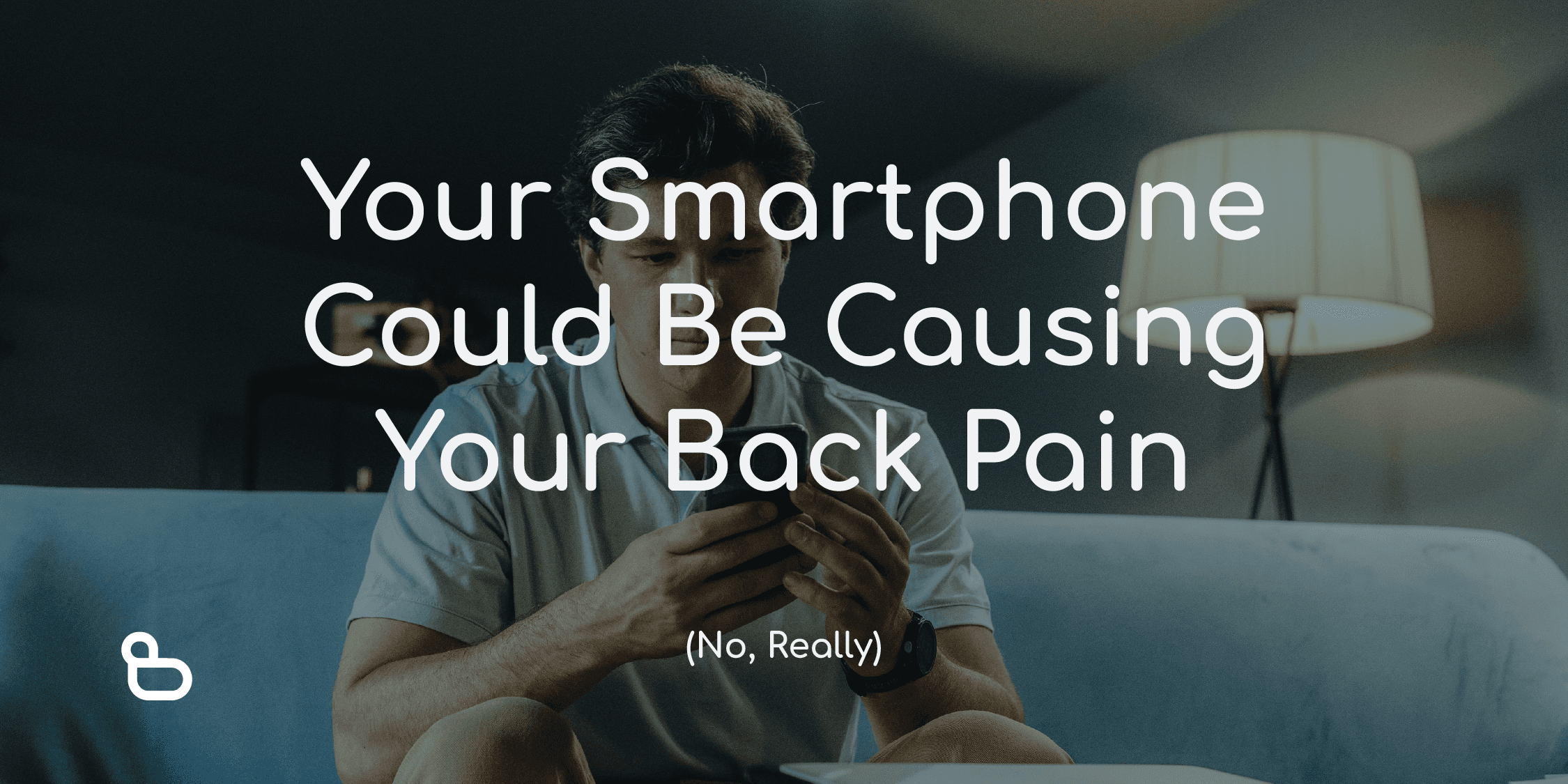Your Smartphone Could Be Causing Your Back Pain (No, Really)
Mar 27, 2024
Chongsu Lee
You might not have thought about how using your smartphone could, damage your muscles, misalign your spine and lead to back pain, neck spasms, joint inflammation, stiff shoulder joints, pinched nerves, and even herniated discs. But it can, and it does.
It's what we now commonly refer to as 'Tech Neck' or 'Text Neck' and it is caused through the repetitive strain on muscles and tissues from the awkward angle of the head when we use our phones, computers and tablets. I know what you're thinking: it's a bit dramatic to claim holding your head at a slight angle could cause so much damage. Well, that's the human body: dramatic.
Your head is heavy (weighing about 10 to 12 pounds) and your neck muscles are designed to keep it upright so you don’t really feel that weight. However, when you tilt your head forward to look at your phone the weight of your head increases the strain on your neck and that strain then travels down your spine, leading to chronic neck and back pain over time.
And let’s be honest, this is a problem that's only going to get worse as smartphone usage continues to rise. Recent data reports that people spend, on average, 7 hours of their day looking down at their smartphone or computer. That’s a lot of pressure on your neck and spine.
How Heavy Is Your Head?
Part 1: The Snowman Analogy

The snowman: iconic winter tradition, beloved British animation, ideal candidate for a tech neck analogy.
A snowman is commonly made from 2-3 balls of snow, with the smallest one at the top representing the head. As most of you will be aware from experience, few snowmen are built to be structurally sound and it never takes long before the 'head' starts to wobble, sag to one side, and then eventually fall off.

So why is the snowman relevant? Well, technology is changing the way we use our bodies and like the precariously balanced snowballs that make up a snowman, when we use our phones, tablets and computers, our 'snowballs' become misaligned.
Luckily, however, we are not made out of snow, so our heads won't topple off as a result. Even luckier, perhaps, is that snowmen do not have human anatomy, because if they did, their neck muscles would be very very strained.
How Heavy Is Your Head?
Part 2: The Science Behind Tech Neck
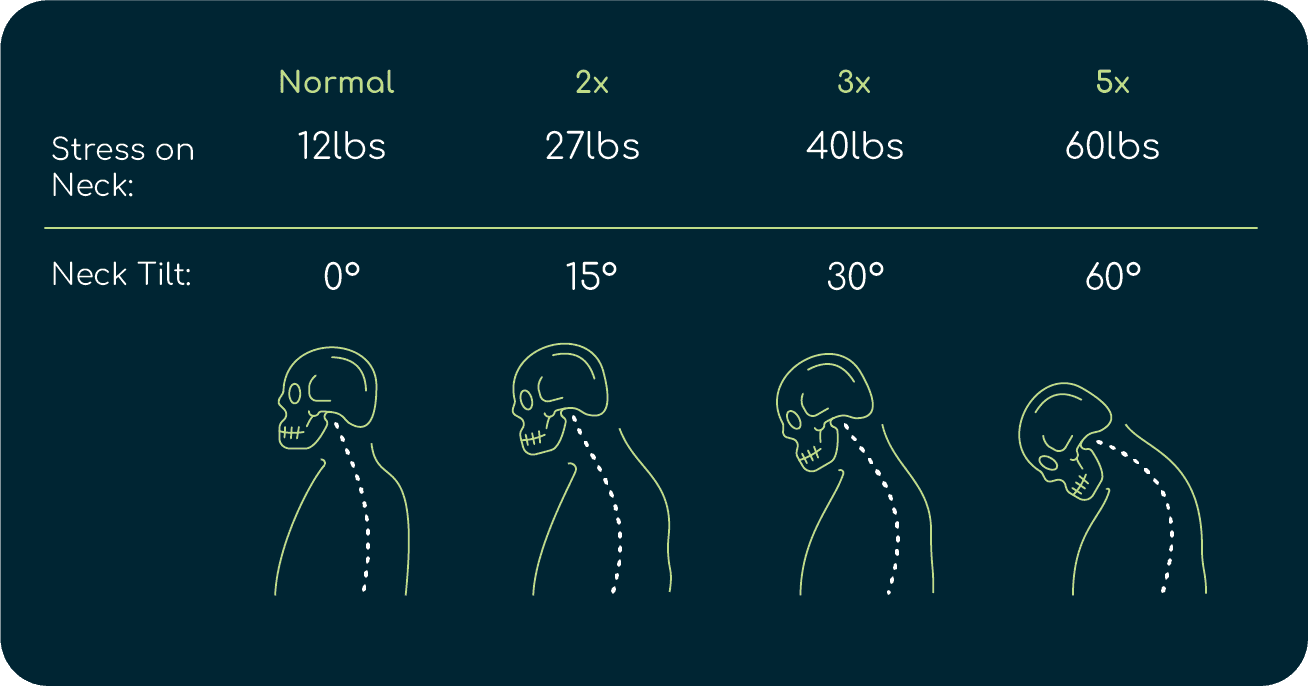
An adult head weighs about 12 lbs on average. However, if you move your head even a little bit forward from where it is when you’re keeping it perfectly straight, the weight bearing down on your neck increases dramatically.
For example, when your head bends by as little as 15°, if you are bending forward to look at the menu on the table in a restaurant for example, the weight on your neck more than doubles, to 27 lbs (if you have an average weight head). When the head bends by 30°, the impact trebles and the load your head is putting on your neck increases to 40 lbs (again, for an average weight head). In extreme cases, where the head is bent by 60°, the load on your neck increases to five times the weight of your head!
How Heavy Is Your Head? Every millimetre your head goes beyond the central line, which represents good posture, the load on your neck increases dramatically. As a result, all the joints and muscles in your neck are forced to work much harder, and eventually get stiff and misaligned
As a result, your neck joints get stiff and go out of alignment and your muscles get tight. The nerves and blood vessels around the neck joints become squeezed. That is critical, because those nerves and blood vessels travel all over the body, to the head, face, shoulders, arms, elbows, wrists, and hands.
You can look at the neck as being the most significant highway interchange for nerves and blood vessels in the body. That’s because the neck connects the head to the rest of the body. If that critical highway is blocked or damaged, it can cause significant pain and discomfort (Ogoke, 2000).
“Do I Have Tech Neck?”
The Signs and Symptoms To Look Out For
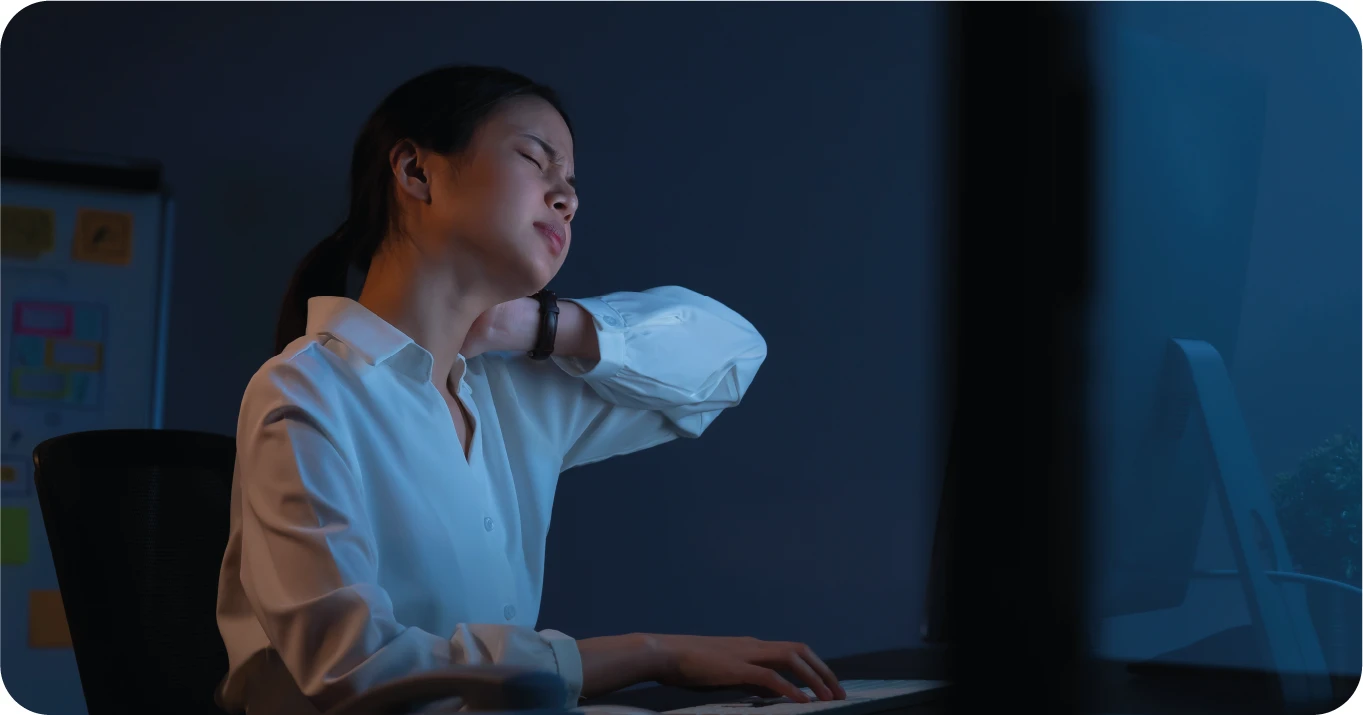
If you’re reading this, there’s a good chance you have a stiff neck. You may have had it for a few months, or maybe for so long you’ve forgotten you had it and you've simply gotten used to it. "it's just one of those things that happens more as you get older". Either way, it wouldn’t surprise me if you suffered from:
Tension headaches (The most common type of headache, Hvedstrup et al. 2020)
Pain in the back of your eye
Brain Fog
Feeling unusually tired, even after sleeping eight hours at night (learn more about how pain and lack of sleep affect one another)
Compromised hearing (Zeigelboim et al. 2016)
Even pain in your elbows or hands can be stiff neck-related.
Performing A System Reset
How To Realign Your Body and Relieve Your Tech Neck
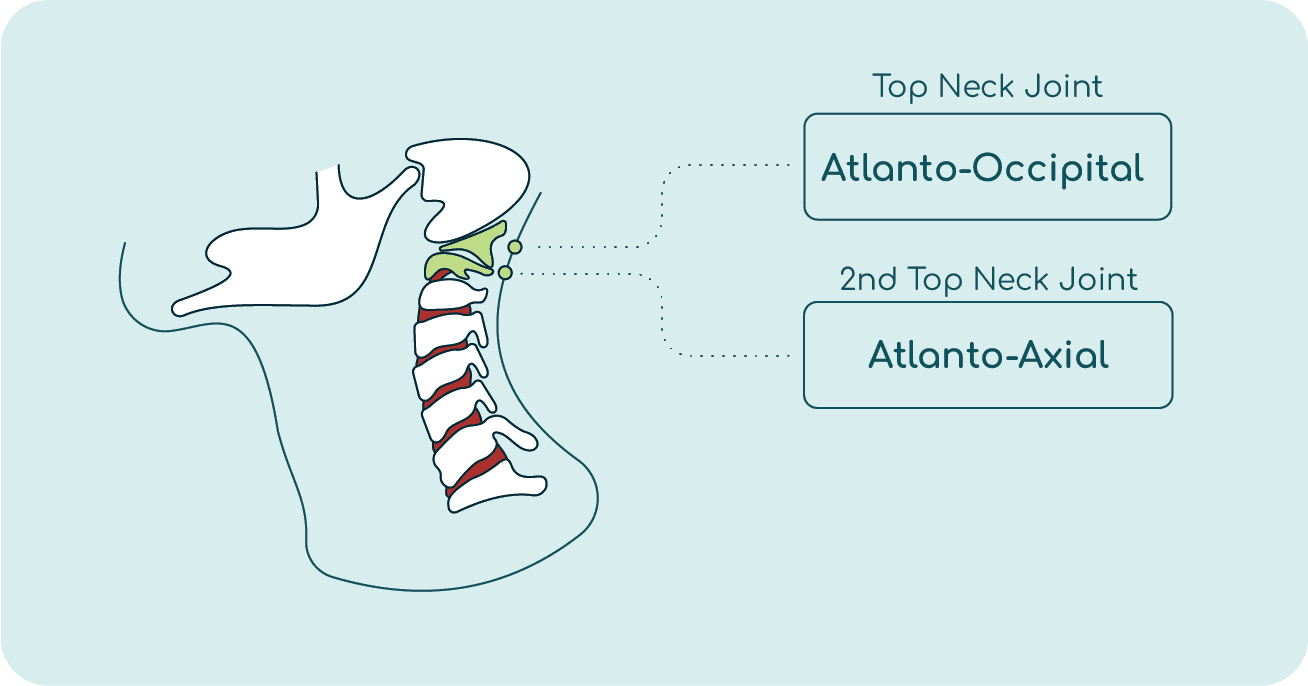
The top joints in the neck, which are just underneath the head, are most affected by prolonged sitting or smartphone ‘texting’ neck. When those top neck joints are jammed, people can experience all sorts of symptoms, including nausea, blurry vision, insomnia and even tinnitus (Ogoke, 2000). So, the most effective treatment for the neck aims at releasing that stiffness and fixing the misalignment in those joints.
Although painkillers for headaches may seem like a quick fix, what you really need to do is relax the tension in the joints in your neck, especially the top of your neck.
Head Gliding:

If you suffer from a stiff neck, follow the exercise below daily, and your neck will feel looser and liberated (the exercise is from Dr Alan Mandell).
Support your chin with your left hand, place your right hand at the back of your head
Gently lift your chin with your left hand, while the right hand pushes the head forward, creating a gliding forward motion of the head. Repeat 10 times
Turn the head to the left, repeat 10 times
Turn the head to the right, repeat 10 times
BackHug:
Patent-protected technology is what makes BackHug so effective, and with special neck fingers that are designed to treat the top neck joints, it is able to loosen tension exactly where 'Tech Neck' causes the most damage.
How to treat your neck with BackHug:
First things first, make sure you're properly positioned so that the neck fingers can accurately treat your top joints.
Then, in your session settings, you can choose "neck focus" as your program.
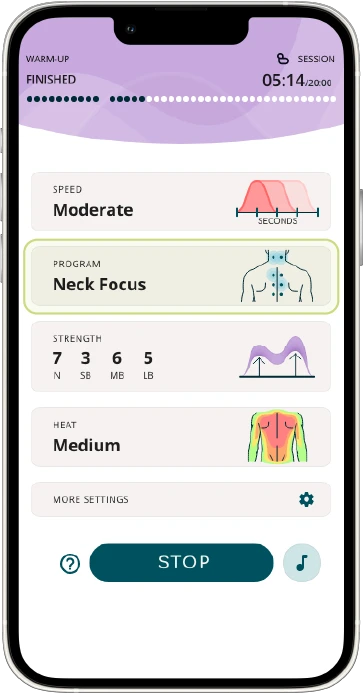
In more settings, you can adjust the type of neck treatment.
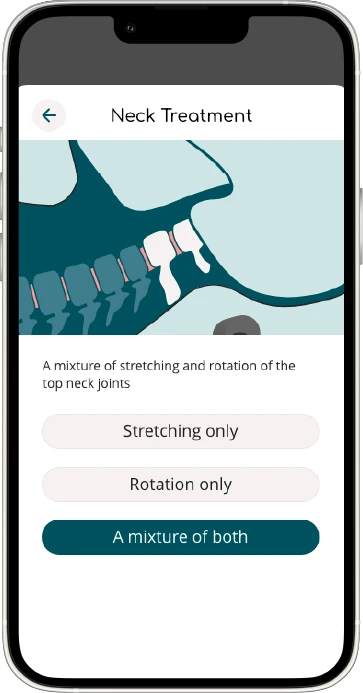
Other ways you can reduce tension in your neck include: holding your phone at a higher angle to prevent strain, taking regular break from screens and devices, and doing gentle neck and shoulder exercises.
and if you want more helpful tips and tricks to reduce tension and pain in the neck muscles. You can watch Chongsu's video on neck exercises that help to relieve headache tension:
Sources:
Hvedstrup, Jeppe, et al. “Increased neck muscle stiffness in migraine patients with ictal neck pain: A shear wave elastography study.” Cephalalgia: International journal of headache, vol. 40, no. (6), 2020, pp. 565-574. pubmed.gov, https://pubmed.ncbi.nlm.nih.gov/32295400/#affiliation
Ogoke, B. “The management of the atlanto-occipital and atlanto-axial joint pain.” Pain Physician, vol. 3, no. 3, 2000, pp. 289–293. PubMed, https://pubmed.ncbi.nlm.nih.gov/16906186/
Zeigelboim, Bianca, et al. “Neurotological Findings at a Health Unit for Adults with Cervicalgia.” Int Arch Otorhinolaryngol., vol. 20, no. (2), 2016, pp. 109-113. NCBI resources, https://www.ncbi.nlm.nih.gov/pmc/articles/PMC4835335/
